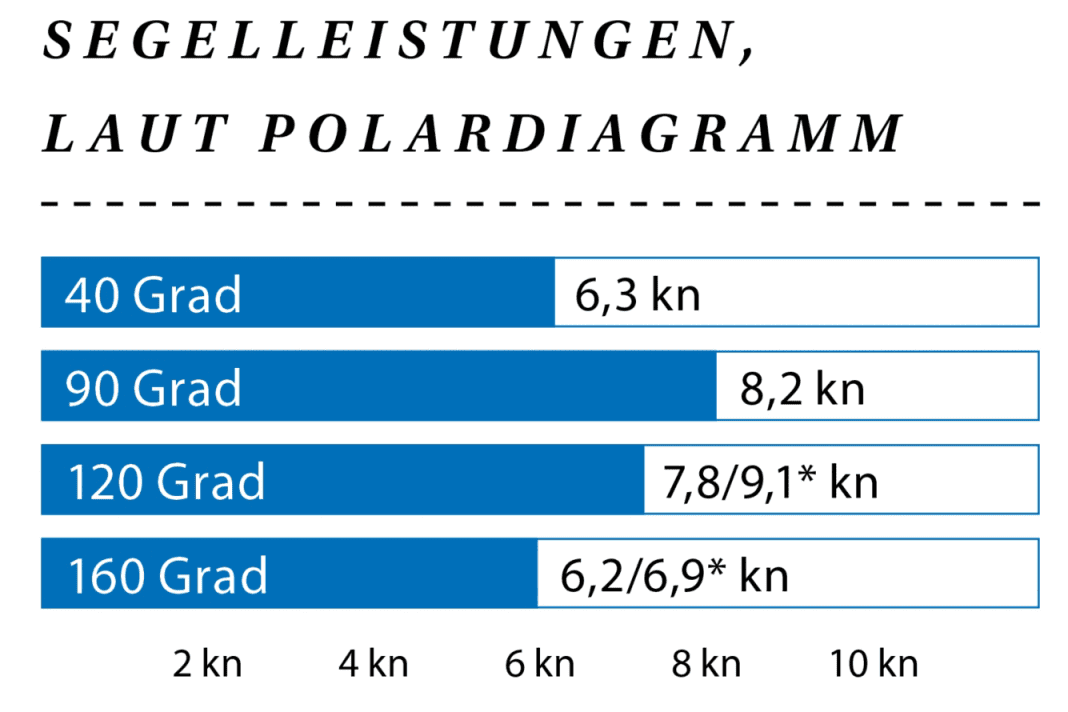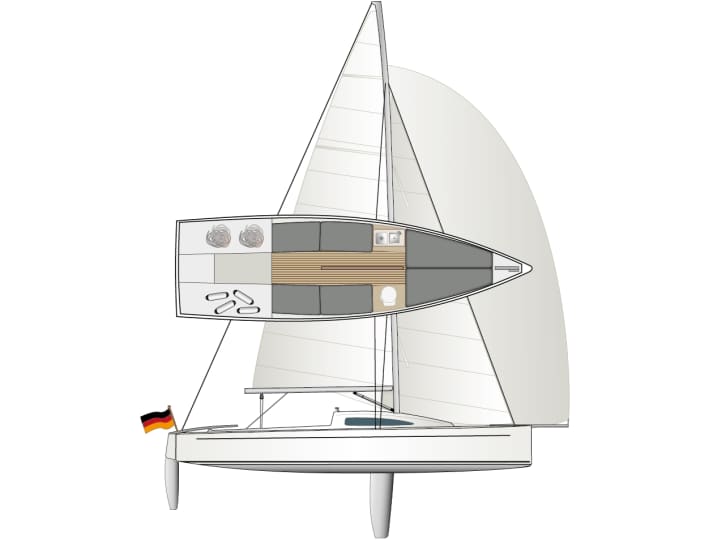





The dinghy cruiser is a type of boat that is over a hundred years old. In the 1920s, it was particularly popular in the waters of Berlin and Brandenburg and was quickly used as a cruising and regatta boat, which led to it being categorised into different classes. One of the most prominent owners was the physicist Albert Einstein. In 1929, he was given the 20-metre dinghy cruiser "Tümmler" as a gift and sailed the Templin and Schwielow lakes with it.
Dinghy cruisers spread throughout Germany, but today they are more of a niche product. Class rules, wooden construction paired with high maintenance requirements and regatta high-tech - all this drove prices to dizzying heights and created a kind of Sleeping Beauty hedge around the once successful boat.
The modern dinghy cruiser
The JK 28 is something like the revitalisation of the dinghy cruiser segment. A new, modern dinghy cruiser that has adopted the proven virtues of this type of boat, paired with interesting modifications. The classic silhouette has been retained: long, flat, with a straight stem and low cabin. In order to have more space than the original 20 dinghy cruiser, the hull was lengthened, measuring 8.50 metres instead of the maximum permissible 7.75 metres of the 20, which puts it between the 20 and 30. Nevertheless, the JK 28 is only 2.55 metres wide so that it can be trailered without a special permit. This also means that narrow berths can be used.
Wherever a Varianta or Neptun 22 fits, a JK 28 can also fit. The elongation has resulted in a relatively slim boat. However, this does not result in any noticeable space disadvantages for use in the harbour, in the reed belt or when sailing.
Open air as a dinghy cruiser lifestyle
The original utilisation concept of a dinghy cruiser has been retained. The actual living space is the cockpit; below deck is for sleeping only. The forward berth is over two metres long and almost 1.90 metres in the head area, which is huge for this type of boat. However, the 80 centimetre width in the footwell is particularly remarkable, offering a fully-fledged double berth. This is made possible by the greater length of the hull, which means that the forward berth does not have to be pulled right into the (pointed) bow. There are also two dog berths, each with impressive dimensions - atypical for dinghy cruisers. Normally, their main bulkhead is only pierced by the companionway. However, by dispensing with bulky forecastle boxes, this space can be used as a footwell on the JK 28.
There is more than enough space for two people to spend the night, but even four people can survive a weekend cruise including a good night's sleep, which is otherwise only possible on specially designed 20ers.
Lots of buoyancy volume
The aft section is sealed off at traveller level. The entire aft area is easily accessible via three hatches and can be used as storage space. The sections under the forward berth and under the cockpit floor are designed as watertight buoyancy chambers, which contributes to increased safety. Because even this dinghy cruiser can capsize.
Living comfort at camping level
The equipment is reduced to a minimum. A cooking box contains a camping cooker, a water canister and a washing-up bowl. It is not possible to cook below deck due to the proximity to the fittings, but the box can be completely removed and placed in the cockpit. This cooking box is part of the "Beautiful Living" equipment package, which also includes the bunk cushions, Alcantara-look interior panelling, teak and stainless steel upholstery and trim. The on-board toilet is also included, either a chemical toilet or, in its simplest form, a hole with an inset plughole in the bench seat below deck.
Fast tent construction
To ensure that the main living area of the dinghy cruiser, the cockpit, can be used quickly and easily, the necessary cake stand has been integrated into the overall concept. A channel has been moulded into the side decks, into which the poles of the shack are laid and therefore do not have to be laboriously put on and taken off - all you have to do is throw over the tarpaulin. The channel also serves as a water drain and guarantees a dry bum. The cake stand is optionally available in the "Touring package.
Dinghy cruiser with increased safety
The biggest difference to a conventional dinghy cruiser is the ballast centreboard, which is otherwise prohibited by the class rules. The carbon half-shells filled with lead weigh 225 kilograms. It can be completely retracted into the centreboard box, which can be done quickly and effortlessly thanks to a large magic wheel in the bow. Although this does not turn the boat into a sea-going keel yacht, it does increase capsize safety.
Without a crew, around 17 kilonewtons, i.e. around 17 kilograms of righting force, were measured at the masthead with the sails set at 90 degrees heel; with two people on the edge, around 14 kilograms. This means that the boat would still right itself even in this position. This provided a weighty counter-argument to one of the primal fears of centreboard boat sailors, that of capsizing. However, at heeling angles of 20 to 25 degrees, for example when sailing upwind, the weight on the 1.75 metre deep lever arm hardly reduces heeling; it rather ensures that the boat sinks a little deeper, which widens the waterline and increases dimensional stability.
But the JK 28 has enough of this anyway, as it is intended to be a cruising boat and not just a regatta yacht. The U-frame is kept very wide, the side decks slope very straight and the foredeck is full. When entering the side deck in the harbour, the Jolli therefore hardly leans to one side, which gives a robust first impression. But even on the Elbe in gusty winds between 3 and 5 Beaufort, there was never a feeling of insecurity. Even if the boat did lean more strongly to one side in a hard push, it remained at around 35 degrees, drifted a little crossways, luffed up on its own and righted itself again.
Agile sailing behaviour
The ballast, which is atypical for a dinghy cruiser, is not at the expense of agility. The JK 28 can be turned on the plate during harbour manoeuvres under sail; an outboard motor is not necessary for experienced crews. On the water, the dinghy cruiser reacts more like a dinghy than a cruiser when the tiller is turned. The perfectly executed carbon rudder system also contributes to this very pleasant and controlled feeling, which works without play and, thanks to sophisticated technology, enables the blade to be raised and lowered without effort.
The rig is modelled on that of the H-boat and scaled up by around 15 percent. Thanks to the unstayed masthead, the tube can be bent very sharply via a tackle in the upper section, allowing the mainsail to be trimmed flat. This is particularly convenient in gusty winds, as otherwise you would have to reef earlier. Under gennaker, however, the dinghy cruiser needs a lot of pressure to start planing. At only 3 to 4 Beaufort, the large wetted surface of the boat still "sticks" to the water due to the U-span. However, if the pressure is sufficient, the 58 square metre gennaker can quickly reach speeds of 12 knots and more.




Very light dinghy cruiser for the size
Agility is achieved primarily through lightweight construction. The hull and deck are manufactured with a foam core and vinyl ester resin throughout. The hull is stiffened by the laminated fixtures, with no inner shells. In order to achieve smooth surfaces, these are levelled and sanded, then painted - a complex process.
The laminating work was initially carried out by Rega-Yachts in Poland. Today, boat builder Thomas Bergner produces the entire boat himself near Hamburg. He is best known for his fast and successful 20 dinghy cruisers. The experienced boat builder and regatta sailor guarantees that all the operating equipment on the JK 28 is not only of high quality, but also functions perfectly. Thanks to its design, the entire boat only weighs 1030 kilograms, which means it can be towed on a trailer weighing around 400 kilograms with compact class cars.
Acceptable entry-level price
"What costs nothing is worth nothing", Einstein is said to have said. The JK 28 is available with ballast centreboard and carbon rudder, Harken fittings, Andersen winches and Dyneema rigging for just under 60,000 euros, but only with Dacron sails. This makes the boat fully sailable and, above all, very well equipped. Even with extras, the price of this dinghy cruiser is far removed from its role models - in a positive sense.
There is virtually no competition for this type of boat. Similarly long small cruisers have a significantly higher ballast ratio, variable draught is almost exclusively achieved using lifting or swing keels, and most of them are also space-optimised mini-yachts with correspondingly lower sailing potential. This lack of competition has made the JK-28 a well-known boat both inland and on the coasts.
This article first appeared in YACHT 23/2015 and has been revised for this online version.
The video of the test
Technical data
- Designer Judel/Vrolijk & Co
- CE design category C and D
- Hull length 8.50 m
- Width 2.55 m
- Draught 0.20-1.75 m
- Weight 1,030 kg
- Ballast/proportion 225 kg/22 %
- Mainsail 18.8 m²
- Genoa (105 %) 12.6 m²
- Outboard engine

Hull and deck construction
Sandwich laminate with PVC foam, outside and inside E-glass with vinyl ester resin in infusion process
Base price ex shipyard
59,000 € (as at May 2023)
Guarantee/against osmosis
2/2 years
Shipyard and distribution
Thomas Bergner Bootsbau, Industriestr. 30, 24610 Trappenkamp; www.bergner-bootsbau.de
YACHT rating
A fast, agile dinghy cruiser with significantly increased capsize safety thanks to the ballast centreboard. The range of berths is above average and the price is well below that of a 20-metre dinghy cruiser. Can be trailered without a special licence due to its narrow beam.
Design and concept
- + Low draught, high variability
- + Increased space
- + Fair pricing
Sailing performance and trim
- + High speed potential
- + Perfect trimming facilities
Living and finishing quality
- + Good surface finish
- + Integrable cake stand
Equipment and technology
- + High-quality fittings as standard
- + Very sophisticated operation

